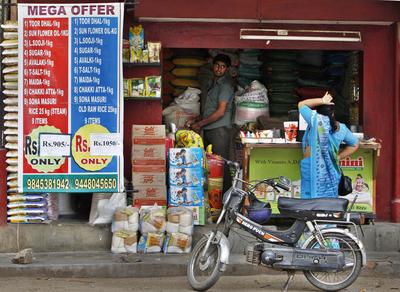Pushing through all these long-pending reforms looks set to be a politically difficult and contentious process. But if successful, it would certainly bring back investors’ confidence and growth momentum, which has been on a downturn for the last seven consecutive quarters. India needs bold policy decisions and the current reforms have come at the right time.
The cabinet’s decision to allow 51 per cent FDI in multi-brand retailing is a big step and will change the way business is conducted in India. The policy comes with a few conditions keeping in mind the interests of kirana (mom-and-pop stores), improving supply chains and getting Indian small and medium enterprises (SMEs) to adopt the latest technologies. The conditions are that FDI in multi-brand retail is to be allowed in the 51 cities with populations of more than one million; 30 per cent of total procurement is to be made from Indian SMEs; 50 per cent of the total FDI fund must be invested in back-end infrastructure; and veto power is to be given to states to allow foreign multi-brand retailers.
There are many economic advantages, particularly for consumers and producers. The scale economies and assured supply chains of organised multi-brand retailing would offer a better variety of products at lower and stable prices to consumers. Further, big retailers would buy products directly from farmers and producers, cutting out the middlemen and making way for better price realisation. Requiring 50 per cent of the FDI fund to go to back-end infrastructure such as storage, logistics and better extension services will substantially reduce wastage and trade and transaction costs. This in turn will reduce volatility in supply, which will reduce price volatility, particularly for perishable goods. The provision requiring overseas retailers to source at least 30 per cent of their goods from SMEs in India will help Indian SMEs to expand capacity, improve the quality of their goods and expose them to international supply chains.
But FDI supported by big retailing will affect kirana shops, as they lack the financial capacity to challenge the variety, quality and packaging of large retailers. Unorganised retailing is most likely to have comparatively slow growth. However, with proper financial support, unorganised small retailers may evolve over time by increasing their product varieties, renovating their store and providing innovative customer catering such as home delivery and credit sales to survive in the market. With the right financial support the kirana may remain competitive.
The new reform measures also allow foreign airlines to invest up to 49 per cent in the civil aviation sector. FDI would be very useful here as the sector is short of capital and on the verge of collapse. India’s civil aviation industry is in crisis, with almost all domestic airlines, except IndiGo, incurring huge losses and struggling to survive. Any FDI inflows into the sector can improve connectivity and boost technology upgrades and management practices. The government has also taken care of the security issue, requiring foreign investors to have a security clearance from their home ministry. Most importantly, Indians will retain ownership rights with a majority stake.
An increase in FDI equity from 49 per cent to 74 per cent in broadcasting services, the disinvestment of four public sector undertakings and a hike in diesel prices strongly signals the government’s intention to push significant reforms. The huge fuel subsidy is responsible for more than one-third of the total fiscal deficit and it cannot be allowed to continue to increase as it might create structural imbalances in the Indian economy like it did during the 1991 crisis. The same resources could be spent more productively on economic and social infrastructure leading to sustainable and long-term growth. With the announcement of these major reforms, the central government hopes that the Reserve Bank of India will bring down interest rates by 50 basis points, which will give a further boost to investors and the Sensex stock index.
These crucial reforms will hopefully restore confidence in the Indian economy. The reforms will potentially change the perception of the international community and investors — particularly after international credit rating agencies threatened to downgrade India’s rating to junk status — and improve India’s image as an investment destination. This is a good opportunity for international retailers to tap into the Indian market and exploit the purchasing power of India’s fast-rising middle class.
It remains to be seen whether the United Progressive Alliance coalition government can withstand the political pressure this time around. The government must stand resolute and take heed of Prime Minister Manmohan Singh’s call that it is time ‘to bite the bullet. If we have to go down, let us go down fighting’. There is still a long way to go on reforms but, looking to the future, if the current reforms can be successfully navigated the next step should be reforms in land acquisition, fiscal consolidation, banking, insurance and governance.
Pravakar Sahoo is Associate Professor at the Institute of Economic Growth, India.

